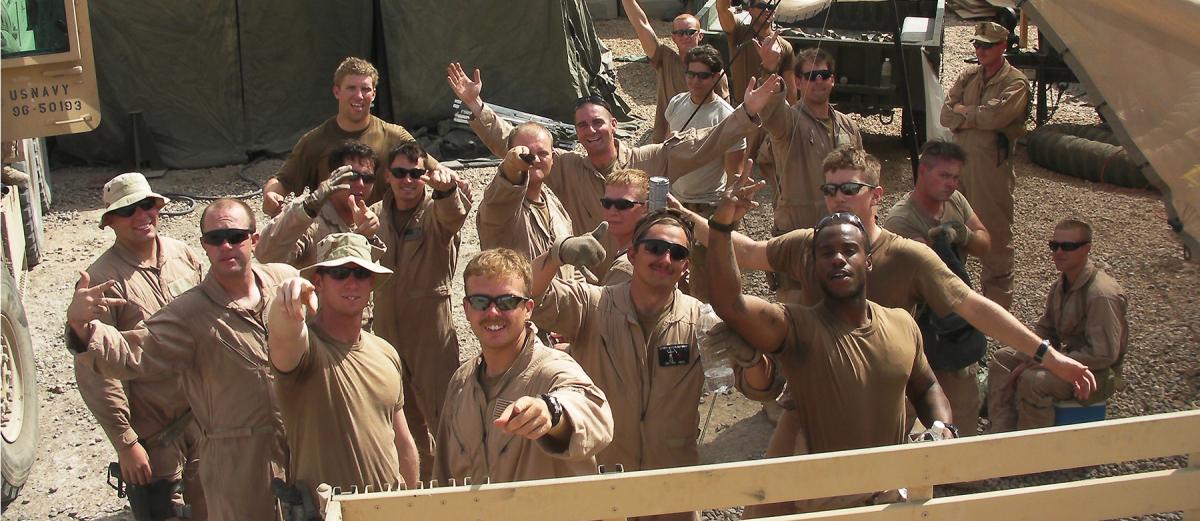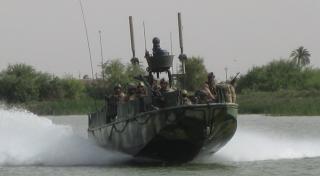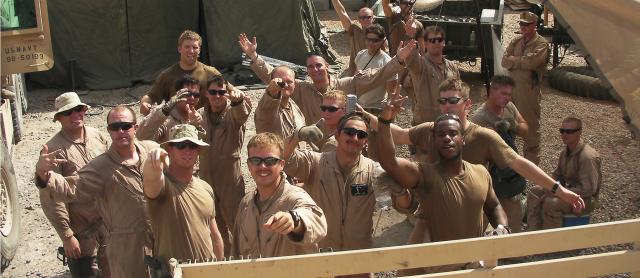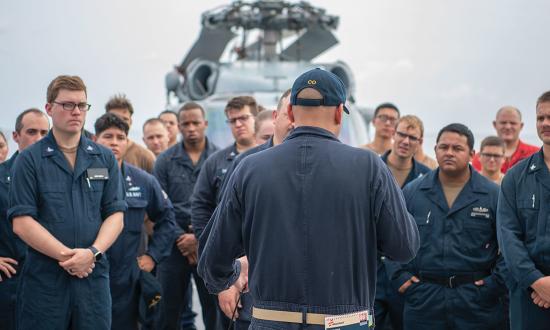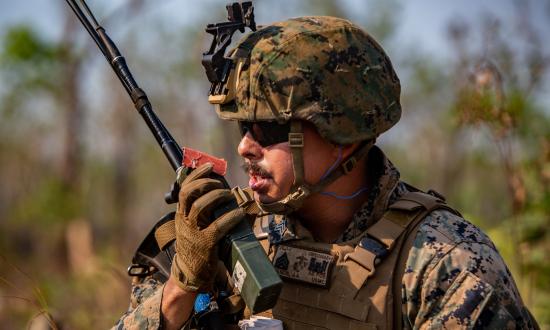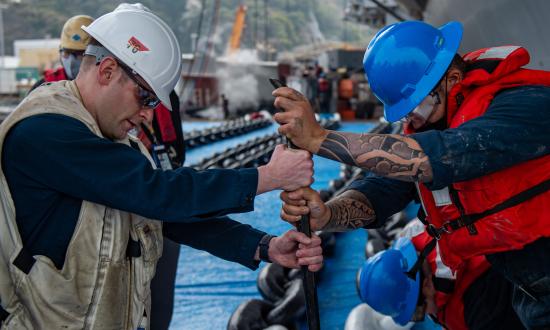Effective teams are built on a foundation of trust, which empowers individuals, encourages open communication, and allows leaders to focus on the big things. Former Secretary of Defense James Mattis put it best when he explained, “The more trust there is inside a unit, the more strain that unit can withstand.” Trust is built through a culture in which we listen, support, and provide honest feedback to our team to maximize the effectiveness of the mission. This lesson was first brought home to me clearly when my team was five months into our 2010 deployment in Iraq.
Build And Demonstrate Trust
The team had just completed what would be our final training mission with the Iraqi special police boat unit in Nasiriya. I had been granted the opportunity to serve in an expeditionary unit as the assistant officer in charge of Riverine Squadron One, Detachment Two, and was riding in the passenger compartment of the first mine-resistant ambush-protected vehicle (MRAP) in a four-vehicle convoy when there was a loud boom that shook the vehicle.
On that day, an outstanding engine- man first class petty officer (ENl) was filling the role of convoy commander for the first time. Although southern Iraq in 2010 was hardly the contentious environment from previous years, with our only contact coming in the form of rockets lobbed into our base a few evenings a week, the other two detachments of our squadron each had hit improvised explosive devices (IEDs) in recent weeks, so we were well aware of the potential threats
At the moment of the IED attack, I had two distinct choices as a leader. I had served as convoy commander countless times over the course of the deployment. It was the ENl’s first time. I would not be overstepping my bounds to take the reins. I had the same resources available and more experience. The other tact required more restraint. The ENl had been endorsed by our detachment, myself included, and proven to command leaders that he could fill the role of convoy commander. I decided to trust him, his training, and his readiness to serve in the toughest of circumstances.
Despite some tense moments, each member of the team demonstrated outstanding initiative in executing the responses we had been taught in training. Vehicles established security perimeters for potential follow-on attacks, sailors—recognizing communications were degraded—took initiative to verify everyone’s status through messengers, hand signals, and oral communications, each vehicle reported to the ENl, who consolidated feedback and passed the information back to higher headquarters. The fourth vehicle in our convoy had been fortunate. The copper-plated IED detonated a breath too early, and, despite the eight-inch arc shaved across the front grill and significant shrapnel to the side of the MRAP, every man returned home that night with all fingers and toes intact.
Reflecting on my expeditionary experience ten years later and following a return to traditional sea duty reminds me that the lesson of trust is just as applicable to the shipboard environment and deserves conscious consideration with increased responsibility of rank and role. As leaders of all ranks there are things we can do—some basic and others more challenging—to build trust and increase the Navy’s combat effectiveness.
Develop Trust Day-To-Day
A foundation of trust—built every day— brings many benefits to a team. Each time you trust a subordinate to carry out your intent you are empowering them. As a department head, I felt significantly greater satisfaction and experienced greater success when my leaders provided me with clear intent and the space to execute as opposed to a micromanaged project with excessive oversight. Empowered individuals are more prone to come up with creative solutions, maintain transparency, buy into the mission, and exceed expectations.
Trust also fosters open communication, keeping your team better informed and motivated and allowing them to bring problems—and successes—to your attention sooner. Identifying challenges and opportunities early allows minor course corrections to have major impacts. An environment that lacks trust forces leaders to withhold information, which can lead to missed opportunities. Open communication tightens the tactical diameter of a commanders’ decision cycle, allowing a unit to exploit short-lived opportunities in dynamic environments.
The most important result of having a strong foundation of trust is that it allows Hie leader to maintain a wider aperture. Division officers can better integrate with their departments when the leading chief petty officer, leading petty officer, and workcenter supervisors are empowered. Department heads can iron out seams across departments and better support the executive officer (XO) and commanding officer (CO) by empowering division officers. When a CO can trust her department heads, she can focus on the ship’s mission, supporting the destroyer squadron’s objectives, and executing the strike group commander’s intent.
As Chief of Naval Operations Admiral Michael M. Gilday recently said, trust is “something you cannot surge.” Officers often have shorter tours on board ships than their enlisted counterparts and are frequently the “new guy” on the team, which can make building trust a challenge. However, some day-to- day habits and long-term strategies can foster a culture of trust that outlasts any individual’s tour and shapes a division, department, ship, and force for longterm success.
One of Hie easiest ways to gain the trust of your sailors is simply to listen. If people are hesitant to speak, help them to do so.
The fundamental shipboard battle rhythm event is quarters. Whether you are a department head or division officer, quarters requires you to be physically present in front of your sailors and is foundational to building trust with your team. Establish an expectation that at quarters your leads will succinctly express their intentions and the challenges they face while you listen, with the opportunity for you to clean up at the end with any new guidance or minor course corrections. Owning the last word, however, does not mean simply broadcasting to your team at quarters. This invites complacency, with sailors showing up in “receive only” mode, kills initiative and innovation, and forces you to micromanage. You must create an environment in which your leads trust that they can tell you their plan. This starts with quarters and carries over into all interactions with your team.
The other less formal but equally important venue for listening to your team is on the deckplates. We were commissioned to lead. We cannot do that solely from our staterooms, the wardroom, on the bridge, or in the combat information center. Friction in our sailors’ day does not always make its way to quarters, and leaders must keep their finger on the pulse of their team to eliminate challenges often accepted as “the way things are.” You cannot be the department head who only talks with the maintenance team when something breaks if you expect them to trust your investment in them.
Support your team. Work with them to shape their plan to succeed with appropriate timelines, cross-organizational coordination, and top cover. As a department head, and especially as a division officer, lead through appropriate touch points, drive the timeline as needed, and manage with proper oversight, but encourage and support your team's plan.
As a leader, you support your team by advocating with your peers and up the chain of command for the resources to succeed. Most evolutions on a ship cross departmental lines and require leaders to build that bridge for their team. If your department needs to put the ship in a training environment to execute drills to hone proficiency, you are the advocate to coordinate with other departments and present the plan to the XO.
Supporting your team also means building a timeline that allows for some failure. Failure cannot be discouraged but rather should be embraced as a learning opportunity to avoid repeat offenses. Initiative and creativity give units a decided edge in combat operations. It is our responsibility as officers to create an environment in which there is space for measured failure to encourage these traits. You owe it to your team to support them this way, and your effectiveness as a leader will be judged more on how you adapt to failure than how you react to things going according to plan.
Provide Feedback To Your Team
The most challenging but critical step in building a culture of trust is providing constructive and timely feedback. Conceptually simple but often overlooked, productive feedback is much easier to provide when frequent interactions and open communication are the norm. Too often department heads press division officers for deliverables, consolidate them, and pass them along to the XO or CO, and then move on to the next task. There is no teaching or learning without feedback, and no trust if it is believed ideas, products, or efforts are simply passed along the routing chain.
Regular, honest feedback builds trust by demonstrating vested interest in improving the performance of individuals and efficiency of the process. Feedback through formal channels such as fitness reports, evaluations, counseling chits, or awards is relatively straightforward, but less conducive to building trust than direct conversations with team leaders and sailors. This feedback drives accountability, without which there is little motivation to improve, change, or go the extra mile to get the job done. Hitting the deckplates and having frank conversations provides direct feedback to sailors, encourages accountability, and ultimately builds trust on your team.
Start With Trust
Future conflict will require leaders who can independently execute orders and aggressively prosecute U.S. adversaries. The greatest technological system—pairing sensors with shooters, longer-range missiles, artificial intelligence—is useless without leaders groomed to seize opportunities and exploit advantage. In Iraq, our team of expeditionary sailors was built on a foundation of trust in which we listened, supported, and provided honest feedback up and down the chain of command to maximize the effectiveness of our detachment.
In a shipboard environment, initial investments in trust pay tremendous dividends over time by unleashing the dedication, creativity, and initiative of sailors. Today’s division officers and department heads must grow to become tomorrow’s commanding officers who can foster a culture of trust and lead with confidence and initiative. It starts on the deckplates, it starts with trust, and it starts with us.



